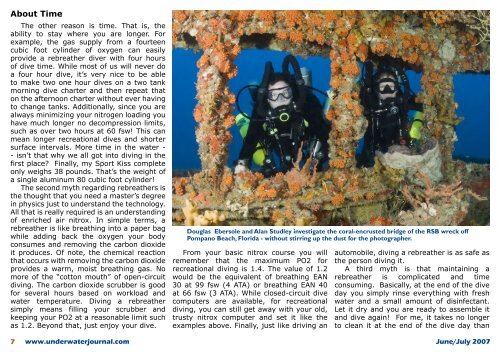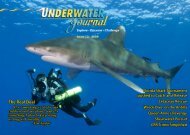- REBREATHERS - SPORT DIVERS ... - Stingray Divers
- REBREATHERS - SPORT DIVERS ... - Stingray Divers
- REBREATHERS - SPORT DIVERS ... - Stingray Divers
You also want an ePaper? Increase the reach of your titles
YUMPU automatically turns print PDFs into web optimized ePapers that Google loves.
About Time<br />
The other reason is time. That is, the<br />
ability to stay where you are longer. For<br />
example, the gas supply from a fourteen<br />
cubic foot cylinder of oxygen can easily<br />
provide a rebreather diver with four hours<br />
of dive time. While most of us will never do<br />
a four hour dive, it’s very nice to be able<br />
to make two one hour dives on a two tank<br />
morning dive charter and then repeat that<br />
on the afternoon charter without ever having<br />
to change tanks. Additionally, since you are<br />
always minimizing your nitrogen loading you<br />
have much longer no decompression limits,<br />
such as over two hours at 60 fsw! This can<br />
mean longer recreational dives and shorter<br />
surface intervals. More time in the water -<br />
- isn’t that why we all got into diving in the<br />
first place? Finally, my Sport Kiss complete<br />
only weighs 38 pounds. That’s the weight of<br />
a single aluminum 80 cubic foot cylinder!<br />
The second myth regarding rebreathers is<br />
the thought that you need a master’s degree<br />
in physics just to understand the technology.<br />
All that is really required is an understanding<br />
of enriched air nitrox. In simple terms, a<br />
rebreather is like breathing into a paper bag<br />
while adding back the oxygen your body<br />
consumes and removing the carbon dioxide<br />
it produces. Of note, the chemical reaction<br />
that occurs with removing the carbon dioxide<br />
provides a warm, moist breathing gas. No<br />
more of the “cotton mouth” of open-circuit<br />
diving. The carbon dioxide scrubber is good<br />
for several hours based on workload and<br />
water temperature. Diving a rebreather<br />
simply means filling your scrubber and<br />
keeping your PO2 at a reasonable limit such<br />
as 1.2. Beyond that, just enjoy your dive.<br />
7<br />
Douglas Ebersole and Alan Studley investigate the coral-encrusted bridge of the RSB wreck off<br />
Pompano Beach, Florida - without stirring up the dust for the photographer.<br />
From your basic nitrox course you will<br />
remember that the maximum PO2 for<br />
recreational diving is 1.4. The value of 1.2<br />
would be the equivalent of breathing EAN<br />
30 at 99 fsw (4 ATA) or breathing EAN 40<br />
at 66 fsw (3 ATA). While closed-circuit dive<br />
computers are available, for recreational<br />
diving, you can still get away with your old,<br />
trusty nitrox computer and set it like the<br />
examples above. Finally, just like driving an<br />
automobile, diving a rebreather is as safe as<br />
the person diving it.<br />
A third myth is that maintaining a<br />
rebreather is complicated and time<br />
consuming. Basically, at the end of the dive<br />
day you simply rinse everything with fresh<br />
water and a small amount of disinfectant.<br />
Let it dry and you are ready to assemble it<br />
and dive again! For me, it takes no longer<br />
to clean it at the end of the dive day than<br />
www.underwaterjournal.com June/July 2007






